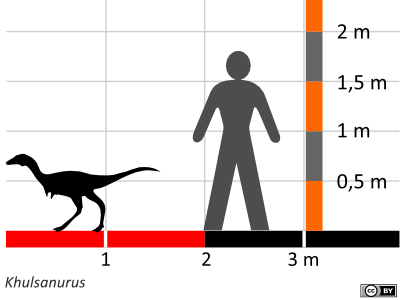
Averianov, Lopatin, 2021
Klassifizierung: Parvicursorinae
Fortbewegung: biped
Ernährung: karnivor
Bedeutung des Namen: Echse aus Khulsan
Khulsanurus magnificus ist von einem Teilskelett bekannt, bestehend aus Hals- und Schwanzwirbeln, Scapulocoracoide, Humerus und Schambein. Das Fossil wurde in der Mongolei entdeckt und stammt aus der Barun Goyot Formation der späten Kreidezeit (Campanium). Die phylogenetische Analyse stellte Khulsanurus in die Parvicursorinae in eine Polytomie mit Mononykus, Shuvuuia, Albinykus und Xixianykus.
Höhe: 60 cm
Länge: 1.5 m
Gewicht: 12 kg
Holotyp: PIN 4487/27
Fundort: Barun Goyot Formation, Khulsan, Wüste Gobi, Mongolei

© Dinodata.de
Weitere Informationen
The second taxon of alvarezsaurid theropod dinosaurs from the Late Cretaceous Khulsan locality in Gobi Desert, Mongolia / Alexander O. Averianov, Alexey V. Lopatin, 2021 / Historical Biology, DOI: 10.1080/08912963.2021.2000976
/ Alexander O. Averianov, Alexey V. Lopatin, 2021 / Historical Biology, DOI: 10.1080/08912963.2021.2000976
- - - - -
Bildlizenz
Größenvergleich © Dinodata.de:
 Creative Commons 4.0 International (CC BY 4.0)
Creative Commons 4.0 International (CC BY 4.0)



